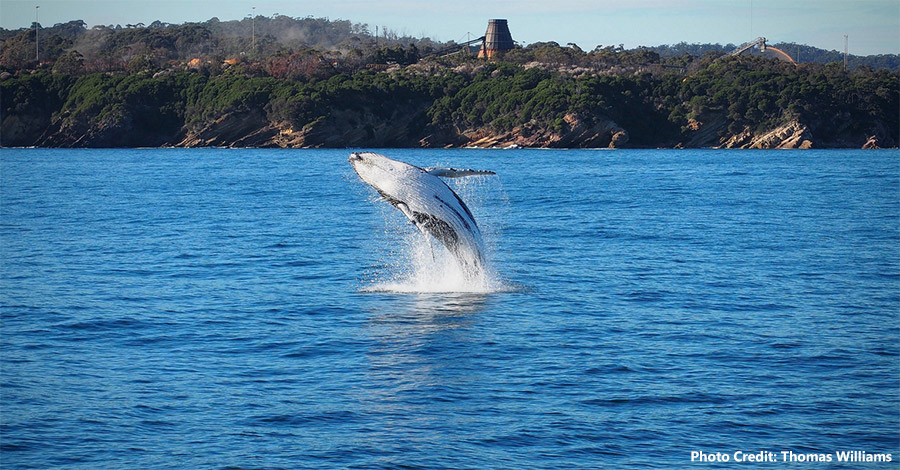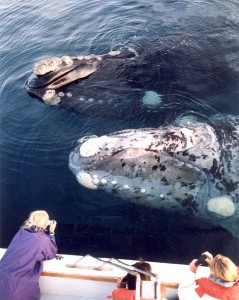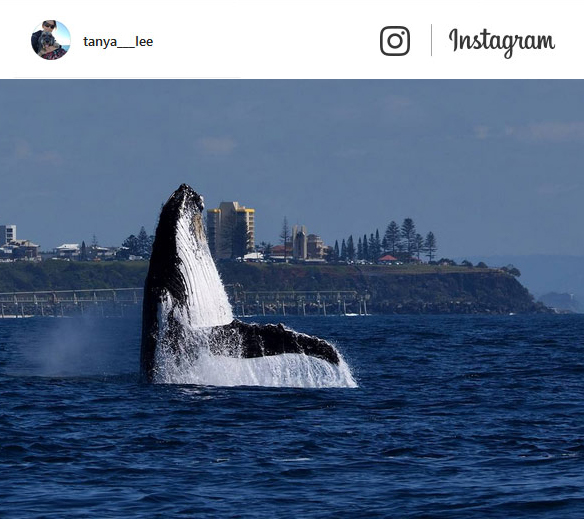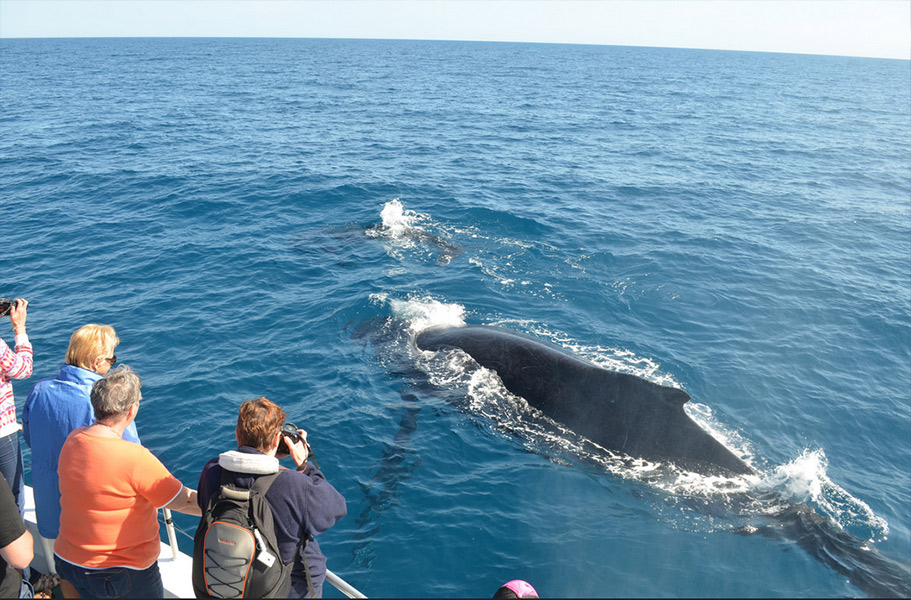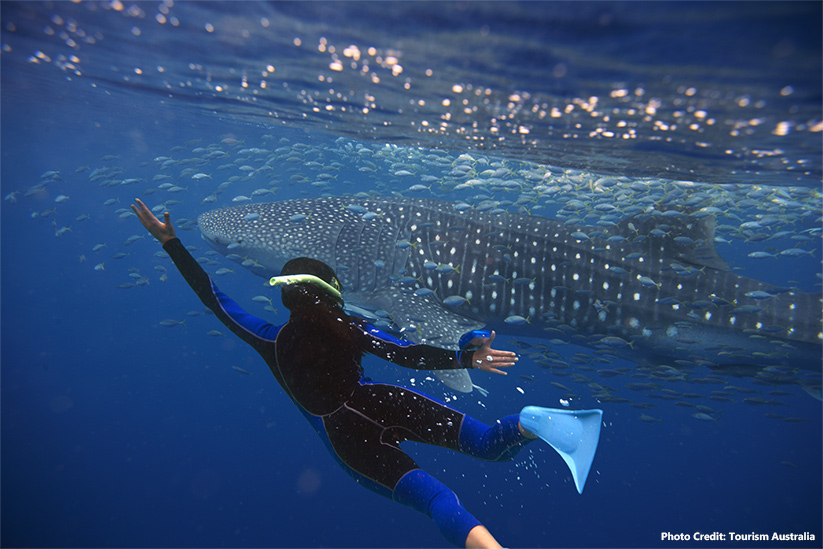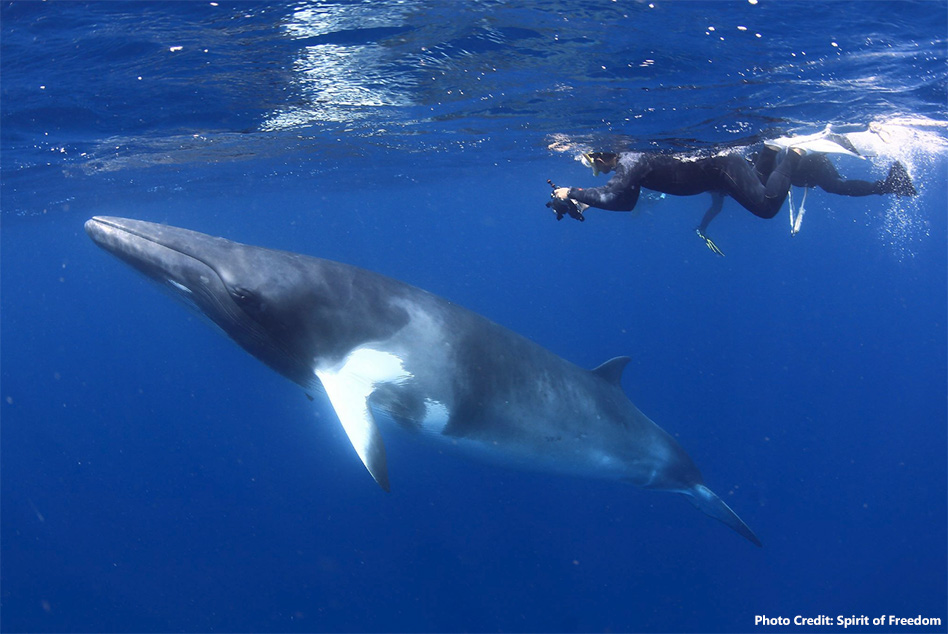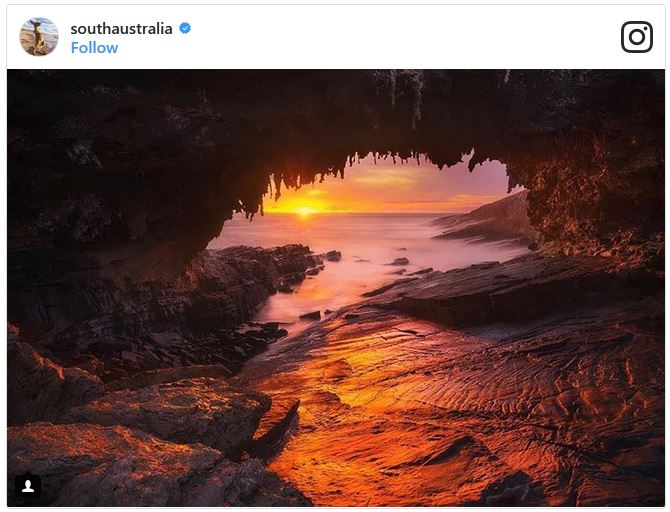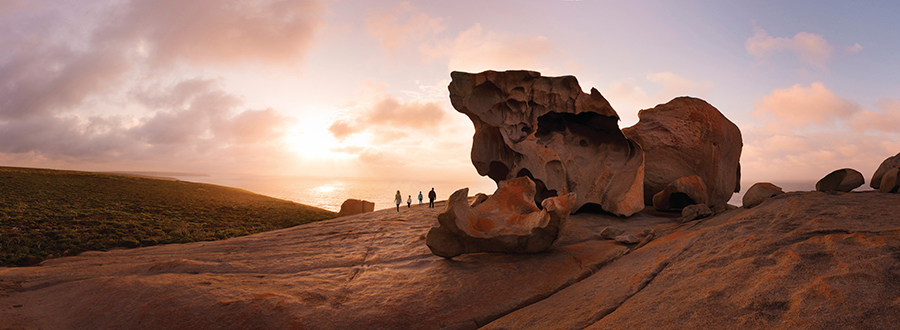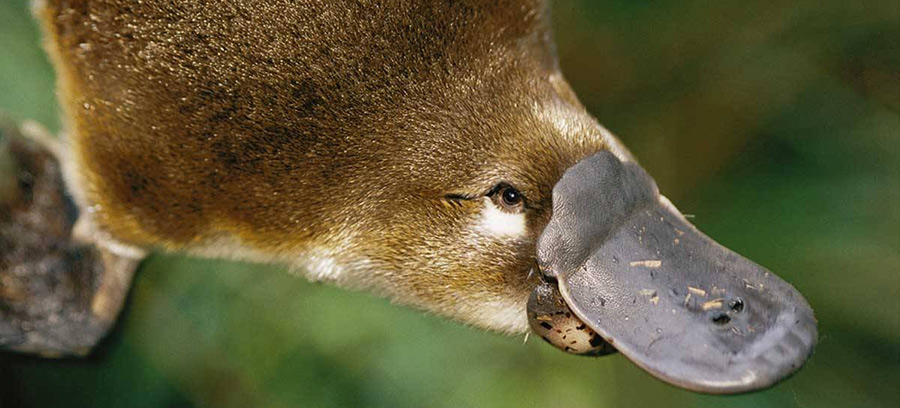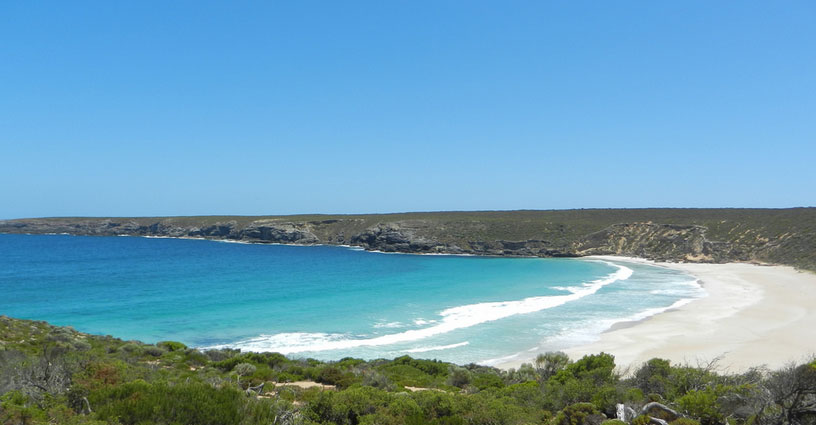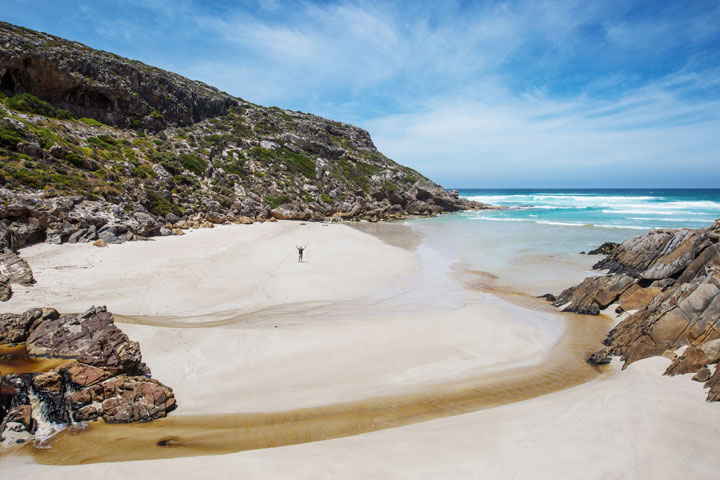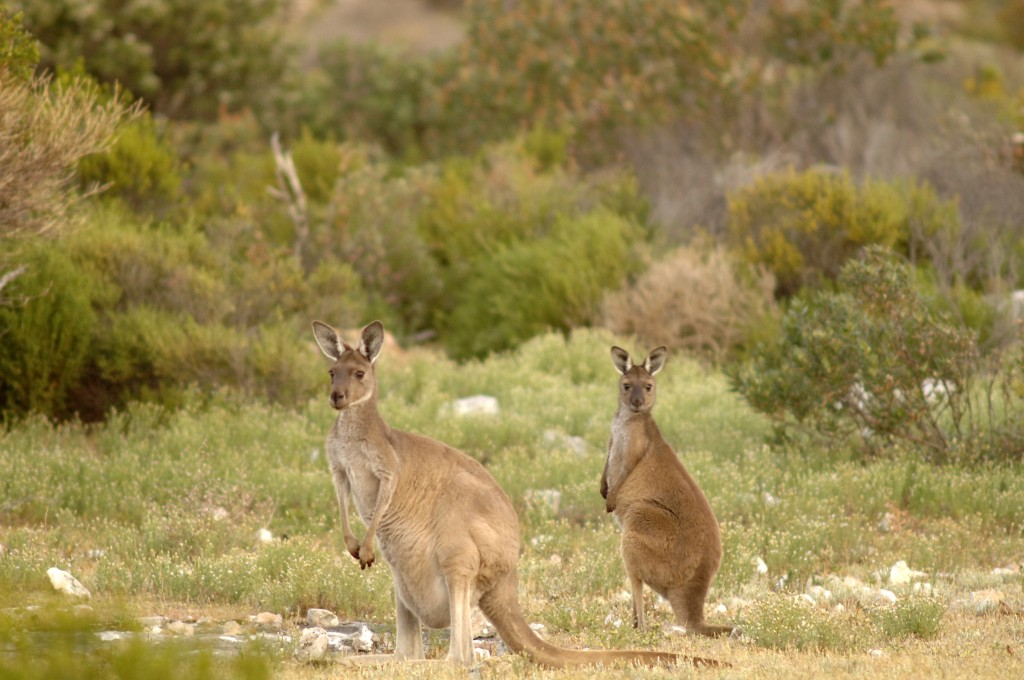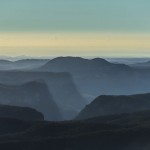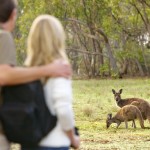Whale Watching Season in Australia
Whale watching in Australia has grown tremendously over the last decade. The long whale season in Australia – between May and November – no doubt contributes to its growing popularity.
But whale watching season differs throughout the country and so do the kinds of whales you’ll see.
In May, whale groups including humpbacks and southern right whales migrate from the waters of the Antarctic to the tropical waters of Australia for mating season. Minke whales and even the rare blue whale also make a stop in Australia’s waters throughout their migration.
The warm waters provide a safe habitat for delivering and nursing their calves, contributing to the growing whale population in Australia. With nearly 60 per cent of the world’s whales found in Australia’s waters, it’s no wonder this is a top whale watching destination.
Make your stop along the coasts of Australia – the best place to see whales – for an incredible opportunity to see these iconic gentle giants on your Australia vacation. Read our guide below to discover the best times to see whales during whale watching season in Australia.
Whale Watching in Victoria and South Australia
Every year along the southern coast of Australia you’ll see southern right whales migrate to the bays of Victoria and South Australia to give birth.
Whale watching season for southern rights in this region is between June and October, when they swim closest to the shores. In Warnambool, Victoria, blue whales are occasionally seen in May.
Cross off two breathtaking experiences at once and journey along the Great Ocean Road on the southeastern coast of Australia. Cruise one of the world’s most scenic drives and stop at popular lookout points to stretch your eyes across the waters below your to spot whales frolicking and breaching. Southern rights are the most commonly spotted whale from different points along the Great Ocean Road, including at Cape Nelson, Portland Bay, and Warnambool.
These curious whales tend to venture close to humans, often swimming close to boats and ultimately lending to an incredible experience with these gentle giants of the sea.
Whale Watching on the East Coast of Australia
Whale Watching in Sydney
The east coast of Australia offers excellent opportunities for whale watching, especially along the coasts of New South Wales and Queensland.
The best time to see whales in popular destinations throughout the east coast ranges between May through July and September through November.
In Sydney, you’ll typically spot humpback whales close to shore making their journey toward Queensland. Humpback whales, like southern rights, are friendly and curious about boats and divers. Their inviting nature has given them the reputation of the most popular whales among whale watchers.
Venture out to the ocean and get a glimpse of humpbacks in their natural habitat with a whale watching cruise in Sydney.
These whale watching cruises typically combine whale watching with sightseeing and information on Sydney’s history. Cruise vessels provide an intimate experience by carrying only up to 11 passengers. You’ll enjoy a private, small group tour along the Sydney Harbor with personalized and knowledgeable commentary about the city and whales throughout your journey.
Soon you’ll be an expert on Sydney and whale behavior patterns.
If you like to cruise in style, Sydney offers luxury whale watching cruises complete with a gourmet luncheon served on-board and drinks to purchase. Comfortable indoor seating allows you to sip on a cocktail while watching the giants of the sea. Or you may take in the blue expanse of the ocean out on spacious viewing decks.
Whale watching has never been so luxurious.
Spot Whales on a Great Barrier Reef Cruise
From snorkeling to diving, glass bottom boat cruises to helicopter tours, there’s no end to the ways you can experience the truly breathtaking wonder of the Great Barrier Reef.
Take a cruise to the reef and not only will you experience the world’s largest living organism – the reef itself – but you may also see whales, the world’s largest animals.
Whale season attracts humpback and dwarf minke whales between May and September to the warm waters of the Great Barrier Reef. The best time for whale watching in this region, however, is between July and September.
Whale Watching on the Gold Coast
If you’d rather keep your feet on the ground but still yearn for the special experience of seeing a whale, Australia’s east coast is the best place to spot whales from the beach.
The Gold Coast is rapidly becoming the premier whale watching site in Australia, with whales venturing as close as one or two kilometers from beach shores. Whales may be spotted all throughout the regular whale watching season in the Gold Coast, peaking in August.
Numerous lookout points along the Gold Coast provide great ocean views where you’ll spot humpback whales breaching and shooting big spouts of mist into the air. Point Danger, a headland on the southern end of the Gold Coast, is renowned as a premier spot for whale watching on land. Other great vantage points include Burleigh Hill and Miami Hill.
Whale Watching in Hervey Bay
Humpback whales make a stop on their return migration to enjoy the waters of Hervey Bay. The clear waters allow you to easily see humpbacks as they frolic and breach, basking in the sheltered waters of Fraser Island with their young. The best time to see humpbacks in Hervey Bay is between July through October, right before they head south again for feeding.
You will typically begin spotting humpbacks twenty minutes into a cruise out on the waters of Hervey Bay – perfect for the eager whale watching enthusiast. Sometimes the whales venture close to the boats, a delightful treat for lucky passengers.
An even better treat is getting to swim with the whales.
Swimming with Whales
Swim with Whale Sharks
The once in a lifetime opportunity to swim with whales awaits at Ningaloo Coast. This World Heritage Site is located in the north-west coast of Western Australia. Here, whale watching adventures can combine a snorkel on the Ningaloo reef with whale watching and swimming on a full day tour.
Take a cruise between March and September for the chance to get up close and personal with these friendly giants.
And the giant you’re most likely to meet on a whale swim is the whale shark. Don’t worry though – classified as the world’s largest fish, these animals are more like whales in their behavior than sharks. These docile creatures are accustomed to swimming alongside humans, with a diet consisting of only micro-organisms such as plankton and krill. So there’s nothing stopping you from taking the plunge and swimming with whale sharks!
Meeting a new friend means first gaining their trust. The same holds true even for these enormous creatures.
You’ll enter the waters with an expert guide in a small group of up to 5 swimmers, so as not to scare off the whale shark. Gaining the animal’s trust may take up to half an hour, but that’s a small price to pay for such a grand experience.
To ensure this exhilarating experience goes as smoothly as possible, a spotter plane flies overhead and alerts the crew on board when a whale is spotted. A photographer joins the swim to capture unforgettable underwater moments you can look back on.
Swimming with Dwarf Minke Whales
Other friendly and inquisitive whales that you are likely to meet on a whale swim are dwarf minkes.
These whales hang around the Ribbon Reefs of the Great Barrier Reef between May and September, peaking in early July. This region is the only place in the world where humans can interact with these whales. With a limited number of tours permitted to offer swimming with minke whales, you don’t want to miss out on this special experience! Day trips and even 3-7 night excursions onto the sea are available for enjoying minke whale watching and swimming.
If you are unsure about swimming with whales, minke whales are just gentle enough to try out the experience. They often seek out human company, swimming around snorkelers and divers and approaching boats just within a few yards. Just another reason why Australia is the best place to see whales – you’re able to experience whales in their natural habitat.
Whale Watching in Australia
All along Australia’s coastline are fantastic spots to see whales. Whether you’re a swimmer and ready for the once in a lifetime experience of swimming with whales, or if you’d rather keep your feet on the ground and see whales frolic in the ocean from the beach or a cruise, there’s a spot in Australia perfect for your style of whale watching.
Want to include whale watching in your trip to Australia? Contact one of our expert Destination Specialists. We’ll set up the perfect whale watching experience for you to see these majestic giants of the sea.
About Australia Reviews
Koda, We just returned from our Australian adventure and wanted to thank you for the great job you did in planning and making all the arrangements. We had such a good time and no glitches of any consequence. That is really something when you are dealing with people our age. All of the vendors (i.e. bus drivers, tour operators, accommodation staff, etc) were great and we would readily reco(...)
We booked flights, hotels, shuttles, and activities with Ana at About Australia.
The range of geographical areas and activities was exceptional
I highly recommend About Australia to anyone planning to travel there.
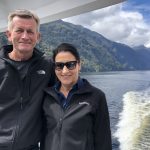
About Australia did a fantastic job planning our trip. We enjoyed the flexibility of designing it based on our preferences. I highly recommend this service!
We really enjoyed our Australia vacation, especially our visits to Sydney, Melbourne, and Port Douglas. Everything went smoothly - no problems with travel arrangements, and the accommodations were comfortable and spacious. Our snorkel/scuba trip to the Great Barrier Reef was wonderful. Thanks to About Australia for helping us plan the trip of a lifetime!
It was an amazing family vacation almost everything was pre-paid and booked we just had to show up and have fun!! Ana was very patient with me and she was able to accommodate all my requeats and answer all my questions.
We had a great time and we were so grateful that About Australia had taken care of all the details. Eventhough we kept making changes to our plans (dates, cities, activities, etc) even during the trip, the staff was super patient and accommodating.
A couple of suggestions: the hotel in Queenstown was not the best (very dated) and it didn’t have air conditioning. We were also surprised whe(...)
Everything went smoothly. The accommodations were conveniently located. The transfers were on time. The Short-Stay property in Melbourne was above average. Cairns was an interesting experience.
Everything was well planned out and taken care of before we flew to Sydney. Plans went smoothly. We had a few changes to make during the planning and Koda was very helpful.
Had a fantastic time. Great flight arrangements, great cities (Melbourne, Cairns, Sydney), great tours, great food! Our accommodations were very nice, but the location of one was a bit inconvenient (better if had a couple of upgrade options in larger cities). For the most part, we had excellent weather; it rained on two touring days but we were still able to appreciate the sites with the exc(...)
Fantastic trip, and so affordable! Great flight, outstanding accommodations with wonderful views--39th floor in Melbourne!--Great Barrier Reef and Penguin Island were excellent experiences! Monique and Yasmine were such entertaining guides. This trip with my daughter was one of the very best in this traveler's memory!
THIS TRIP WAS AMAZING WAS ABLE TO SEE DIFFERENT LOCATIONS THROUHGOUT AUSTRALIA, EVERYTHING FROM THE FOOD TO THE PEOPLE WAS AWESOME. ALL OF OUR ACCOMODATIONS WERE FANTASTIC. ABOUT AUSTRALIA IS THE ONLY WAY TO GO IF TRAVELING ABROAD TO AUSTRALIA.
Overall, our trip was wonderful. Unfortunately, they had to change agents in the middle of planning so we lost some continuity. Majority of accommodations were great. Tours selected wonderful. My only recommendation for those using About Australia, thoroughly check and read all final documents including seat assignments on airlines.
We only have one time in Cairns where the shuttle missed picking us up because the flight was delayed and we have to wait for one and a half hour for the next shuttle
Otherwise, everything else was great! I will recommend it to all my travel buddies.
We engaged with About Australia (Darin Hendry) nine months ago for a recommendation on an itinerary for a first time visit and 20th anniversary trip to Australia.
From the beginning the guidance, interaction and ultimate proposal was spot on.
The 2-week journey offered an exceptional variety of terrain, climate and experiences. First stop the Tablelands, rainforest, then beach town, the(...)
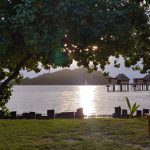
Had a fantastic time in Fiji thanks to About Australia. They were knowledgeable about the location and the resorts they chose for us were spectacular. Thanks for all of your help.
My trip to Australia was amazing! The hotels were impeccable, outings to the Great Barrier Reef and Walkabout to see kangaroos and koalas will last a lifetime. No fusing with transport to and from the airport as it was arranged.Thank you Ana for putting together a fabulous adventure!
In cairns our pickup to airport for trip to sydney was not organized well. The driver picked us up too late and had 6 additional stops! Claudia and I ran to checkin and there was a long line. So she went to priority and I went to service desk. The service desk checked us in. We were lucky to make the flight due to our quick thinking. Also, we were not that pleased with the location of (...)
The trip was incredible. People were unbelievably friendly. Enjoyed the peaceful serenity of Port Douglas. Am very glad we opted for Douglas instead of Cairns. Meridian Hotel was great. Four Mile beach is a must see (sunrise is fantastic) and be sure to climb Flagstaff Hill. Great Barrier Reef trip was ok, but opting not to go into the water was a mistake. Be sure you can tread water or(...)
It was a wonderful trip. well organized. Hotels and people I had to deal with were excellent. I would highly recommend
this outfit to anyone who wants to go to Australia.
The trip you helped me put together for my clients was absolutely perfect!
Thank you so much!!
This is the 1st Australia trip, we already thinking going back!
I have decided to use a travel agent to plan for my family’s trip to Australia, after trying to do it myself for months. I am glad I did. My agent was Ana. I requested her to plan a trip for us with the most affordable way to fly from San Francisco, to have city experience, to see the Great Barrier Reef, to be able to visit my good friend in Brisbane, and have wildlife experience. She came o(...)

About Australia and About New Zealand planned our honeymoon amazingly! From listening to the activities we desired to do while there, to ensuring those happened, and arranging all our flights and accommodations, About Australia was great to work with. Our visas were secured and all our travel documentation was provided, which made traveling a breeze! And we had a lot of traveling to do in the(...)

We had a fantastic experience. Knowing it may be our one and only chance to see down under, we squeezed in as much as possible in 2 weeks. We went to Melbourne, Sydney, Auckland (Tasmania) and New Zealand. The flights, tours and all airport/hotel connections all went off without a hitch. We scheduled many tours but our favorites were the Feeding Frenzy at Bonorong Wildlife Sanctuary in Tasman(...)
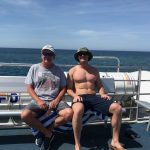
The paper work including what to do pre trip was great, Australia is a long way so Ana extended my return an extra 10 days so I could have more time with son and visit Tasmania. For my return next year I plan on using their services .
Well designed and good value trip, would recommend to friends

Going to Australia and snorkeling at the Great Barrier Reef has been #1 on my "Bucket List" since I can remember! All the stars fell in line this year, so we decided, "This is it...we're going!"
About Australia came highly recommended to us by some friends who LOVE Australia (and are going again with them next year for the 5th time!!), so we contacted them to check them out and get the bal(...)
This was the best trip of my life hands down. I was afraid that since I was saving so much money I would be getting a lesser quality trip, but I was pleasantly surprised!

Jeanne and I highly recommend a trip to Australia and to use About Australia for your arrangements! Everything they recommended we tried to fit into our schedule and it was well worth it. We especially loved Cairns and snorkeling on the Barrier Reef and hope to go back again at some point to spend more time there. One day on the water was not enough!
All of our flight arrangements made by Ab(...)
We usually do our own vacation planning. Grab a Lonely Planet guide book, hop on the internet and get started. I quickly realized that Australia may be different. First, its very large, 95% of the size of continental USA. Second, there is so much to do and see. Third, an itinerary can get very complicated very quickly; multiple destinations, multiple flights, rental cars, and a myriad of(...)

Wow, we booked this trip through About Australia knowing it would probably be our only time to go there. They chose the BEST highlights, arranged EVERYTHING, and it was fantastic! I don't think it could have been better. In Melbourne (Melbin) we did an excellent 3 hour foodie walking tour, rode the free tram everywhere, loved the Market, stayed a an apartment, visited an animal park AND ex(...)
Hassle free if you would like to tackle all three: Northern New Zealand, Southern New Zealand and gold coast of New South Wales, Australia.
Hassle free comes when about Australia was able to arrange shuttles to and from the airport, rental car, airline tickets. Ours were nine flights!. You get the most for your money. Koda did it with such ease and efficiency. About Australia knows what hot(...)
The accommodations were wonderful and the excursions were amazing and informative. Thank you for some amazing memories
Our trip was amazing! Sydney, Fraser Island, and Airlie beach are places we cannot wait to go back to!!! So grateful for the recommendations and trip planning/organization.
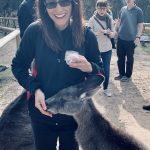
I first asked for a quote, only to find out (while on a short trip) that the trip had been booked. All I wanted to know what the "and up" cost would be for the advertised one. However, it was an excellent price, so I booked it. It seemed too short for the time spent in the airplanes, but we enjoyed the opportunity to see things out of the cities, we added a Dainforest Trip out of Caines, a(...)
Ana did such an amazing job! She was super kind and patient through out the process and helped answer any and every question I had. She did a wonderful job of getting a grasp on what I was interested in and everything I needed to support completing the entire trip. We had fantastic tours, hotels, and transportation the whole. It really took the stress out of the traveling and allowed us to ju(...)
What an amazing experience. The accommodations and extra excursions we did were wonderful. The only thing I would have changed was I wished we had a little more time in Sydney (it was more like a very long layover rather than a visit to the city). Ana was wonderful and helped us plan a trip I will always treasure!

It was an awesome vacation except for the 24 hours of traveling(LOL).
The hotels were great but made you pay for WIFI, the US does not make you pay for it.
I would definitely recommend to everyone.
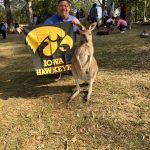
We recently returned from an amazing 3 week holiday to Sydney, Brisbane, Cairns and Queenstown (NZ) organized by Ana with About Australia. We could not be more satisfied with our trip due to Ana's attention to detail and organization. We are experienced travelers (58 countries and 6 continents so far) and like to balance "do our own thing" with occasional organized activities. Ana guided (...)

Overall we were very happy with About Australia and our coordinator Koda.
All the booking and execution of travel, transfers, hotels, etc went smoothly. The location of and quality of the accommodations in Melbourne and Caines were great, and we really enjoyed the tours we did in those cities.
We especially enjoyed the foodie tour we did in Melbourne. Monique, who ran the tour, wa(...)
We had a wonderful time in Australia and loved the convenience and quality product offered by About Australia. The food tour in Melbourne was great and our apartment was modern and lovely. We were very satisfied overall and thank Koda for helping us with our arrangements.
We had a fantastic and wonderful experience. All our connections went smoothly and the Mantra hotels were very clean and in great locations. The three excursions that were booked for us were exceptional. We would definitely recommend your company to our friends.
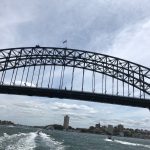
We had a very well planned trip by about Australia, the activities were fun. The rooms were fantastic. Only complaint it wasn’t long enough. I’d definitely use them again and recommend them to friends.
Koda was an excellent adviser and planner to my trip to Australia. She was always very professional, patient, informative and was careful to the minimum detail. I will recommend her with friends and family.

Our trip was absolutely amazing! I usually like planning my own trips, but this time around we were in the midst of planning our wedding as well. In addition, we felt like we did not know enough about the South Pacific to know where wanted to go. Our trip was put together beautifully, and honestly we wouldn’t change a thing. Every single flight and shuttle from the airport was on time, ever(...)
The trip was worth the money. However, VERY disappointed with location of hotel in Sydney. Although BREAKFREE ON GEORGE was a very nice hotel/apartment I did not appreciate being in the middle of Chinatown.
Good enjoyable trip.
Melbourne:
Accommodation: clean, good location, easy transportation
City Food Walking Tour: OK
Philip Island Trip: Good
Ocean Drive: Good
Cairns:
Accommodation: clean, good location
Snorkeling: Good
Aboriginal: Duplicated day and trip events. Should have taken one, not both: the same thing, same casts.
Sydney:
Accommodation: OK, good location, easy transporttio(...)
It was am amazing trip that covered a lot of the country. Only regret was we were running out of time and would have liked to spent more time in each location. Do your study before you go, the instructions in the voucher help but the little things you can miss make it important to study and plan.

This is our first big trip out of the country and using a travel agent. I was extremely hesitant because I am so used to planning everything. As soon as I spoke on the phone with Koda i was so excited and all hesitation went away. We went to Australia for our honeymoon 2 weeks after we got married. We were extremely exhausted so it was nice knowing everything was handled. We felt like we got (...)
I wasn't totally convinced that this would work out. But, it did. Darin Hendry did a fabulous job of making our trip perfect. I was worried- I didn't have to- he's a 5 star pro. We loved it all.
Fabulous trip to Australia and New Zealand. We asked for photography opportunities-- landscape and wildlife and that's just what we got at a reasonable price. Ana was with us every step of the way to include during the trip, when a hotel owner thought we had unintentionally left things in a room. Amazing service-- friendly, efficient and spot on. Thank you to Ana and to the owner, Paul, too, (...)
My boyfriend and I (both 72 years of age) have just returned from a six-week, custom-tailored, independent trip to Australia and New Zealand.
We started talking about this trip over a year prior to our departure date. After my initial 2.5 hour telephone conversation with Christopher at About Australia, I knew we had found the perfect "partner" on whom we could depend to help us with all(...)
We managed to see many of the highlights of several locations in Australia without feeling too rushed. Also received good advice how to plan for the excessive heat, which was quite a change from the snow we left here, and some inside information on hot spots and recommended activities. I especially appreciated Ana's patience as we made some last minute changes in plans. Having the transport(...)
We did 24 days in Australia/Tasmania in March/April and loved it! About Australia made all the custom arrangements and things went so smoothly. We had two small issues which were quickly corrected...thank you! Accomodations were great, flights were easy, and the tours were very nice. Loved Kangaroo Island and Tasmania! Would do it all again :-) Thanks to all the agents who helped us!

I was particularly pleased with how smoothly all the transportation and tour arrangements went. We never had a problem or question about shuttles and everyone was expecting us when we arrived. The trip was fantastic and I wish it could have been longer.
All the planning and the vouchers worked out just fine. No glitches. Well done.
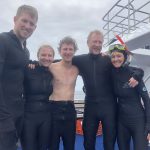
Our first trip to AUSTRALIA did not disappoint! Our Itinarary was perfect for us Alaskan adventurers! A well rounded trip from Sydney to Cairns and so much in between. We hiked in the Blue Mountains and swam at Lake Eacham walked amongst the kangaroo s and Cockatoo s and held the precious Koala bears. We romped in the rain forest and stayed at Rose Gums enjoyed the 3 bedroom treehouse with (...)
We have traveled all over the world. Never have we had a trip so well planned. By the third day, we were checking our itinerary and asking ourselves, “what’s the next adventure?” Everything went like clockwork. Hotels, flights, transfers, tours, all were on time and more than we expected. Our only disappointment was having to come home when it was over. Thank you, About Australia, for plannin(...)
Everything was as good or better than we expected. Sydney was great. Melbourne was very good. The events all worked out well and were better then expected.The return flight was terrible, since it was badly planned by you or Qantas, who ever planned the connection. There was no way for anyone to make the connection to Phoenix. But other then that, it was a great trip. Lou
We loved our time in Australia! The diversity between Melbourne, Cairns, and Sydney was great. We did several tours including the Phillip Island Penguins, the snorkeling/diving in Cairns (would like to do that one about 10 more times!), the Kuranda Rainforeststation, and the Hop on/Hop off tour in Sydney. We also did some extra exploring at those places and thoroughly enjoyed ourselves. We hi(...)
I was very please with our trip to Australia. Although we had a bit of a rocky start, (lack of communication from About Australia), in the end, they delivered everything they said. I was very happy that we purchased the Tours and Transfers add on. It was well worth it. We did not have to worry about getting to and from the airport, finding hotel etc. The vouchers required you to call and (...)
We loved our bucket list trip to New Zealand and Australia. However, we felt there should have been an encouragement from Koda to consider adding a day or two at each destination. We didn't realize that in almost all cases of 2 night stays, an entire day was spend traveling. This left us with little time to explore upon arrival. An example was Melbourne. We arrived in the early evening. The e(...)
Accommadations were excellent except at the Short Stay Apartments where we were required to walk to another of ther properties— The Australis—which was quite difficult for us to get to with all our luggage. I think it was the one at Kangaroo Island that also wasn’t a good experience because of having to climb 2 flights of stairs to get to the room. The trip to the Great Barrier Reef on the Qu(...)
The trip was very nice overall. Very good communication process with About Australia in planning and setting up trip. Agents were pleasant, professional and helpful. The hotels, excursions and shuttles were very good except with a bad shuttle experience in Sydney with RedyToGo both to and from Airport and Hotel. The side excursions and tours booked were very good and well run, especially t(...)
Our 10 day trip to Eastern Australia was extremely enjoyable, and a valuable learning experience. Surfers Paradise was reminiscent of our days on the Jersey shores, only better. The area was very clean, there were many good restaurants and plenty of sites to see. We did sign up for a 1/2 day tour of the waterfalls and rainforest. We could have avoided this since the waterfalls and rainforests(...)
Our flight to LAX was delayed due to weather connections (our booking), and therefore missed our flight to Melbourne. However, Virgin Australia was wonderful & put us on a flight to Sydney just a few hours later with a connecting flight to Melbourne to arrive only 5 hours late [THANKS VIRGIN!]. All accommodations were great [Rose Gums the favorite despite heat]. Also John & Sue in Port Dougl(...)
This was my first time using About Australia and I was extremely happy with their services. They did an excellent job. Everything was just perfect. The transportation, the hotels, the locations was all spot on. My sisters and I were very pleased. I highly recommend anyone visiting Australia and New Zealand to use About Australia. Thank you so much Marissa for everything you did to make our va(...)
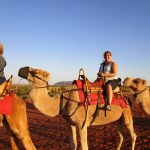
Making dreams come true. My trip to Australia was amazing and worry free
knowing About Australia had made all the arrangements for an adventure of a lifetime
Thanks a million
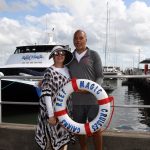
About Australia and Christopher set up the most amazing vacation for us. If there was a rating above 5 stars, we would place these travel experts into that category.
Traveling to New Zealand and Australia had been on our wish list for awhile and putting trust in Christopher with our travel plan destinations was the best decision we could have made.
Thank you for the memories.
Koda Boulton was the one who helped me and she's was amazing even with all my questions and my unfortunate criminal background. Still got in with no problems and had a great itinerary set up. Couldn't have seen Australia in a better way than that. Strongly recommend About Australia. Good price too! Flexible.
We had an amazing trip. We would change a couple of things about our time in Sydney. We were right in Chinatown- maybe 5 Aussies in that area the whole time we were there. No Australian food or the English language anywhere. We did not pay all of this money to stay in Asia. We have Chinatown in the states. The hotel was nice. We took public transportation to see the other parts of Syd(...)
The only feedback I would like to offer pertains to the Penguin Parade excursion. We had no idea how the day would unfold. Turns out, no one was dressed appropriately seeing that Phillips Island is quite breezy and the temps drop as the sun goes down! If you could suggest that long pants, or even a jacket and blanket are brought, would have helped keep everyone more comfortable as we wai(...)
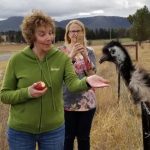
Virgin Australia made the lengthy flight enjoyable.The hotel, Breakfree, was in the heart of town, spacious clean comfortable room and front desk staff bent over backwards to assist us with all kinds of requests. The tours were informative and fun. We had time to do a few things on our own, like having dinner at the top of Sydney tower our last night. On the Blue Mountain tour, we even had an(...)
We truly enjoyed the trip you planned for us. Everything went smoothly, and the activities you chose for us were amazing.
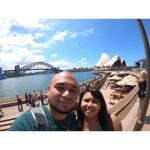
Thank you so much Koda for all the recommendations and the itinerary tips! The stay in Melbourne was centered right in the middle - loved the people, lots to eat, lots to do and see. We loved our stay - our balcony was so beautiful - we loved our view so much! Cairns - loved our hotel and everything was in walk-able distance, we had an ocean view, sunrise was magical - wished we extended o(...)
The entire experience was amazing! From booking in the short time we had, to the surprise of such a great value and then when we were there, we could not believe how wonderful everything was...from the hotels, to the excursions to the flight and transfers. Absolutely flawless, best value and would highly recommend Marissa and About Australia again! Thank you so much for a wonderful experience!
Loved the locations we visited and the planned excursions. The Mantra hotels were ok but not great. About Australia needs to work on their response times since we didn’t always get answers without feeling like we were nagging. And the day of our departure was very stressful with a changed flight ( no fault of About Australia) and a shuttle driver who arrived 50 minutes late and was lost betw(...)
Through the entire trip I kept saying to Betty that I could not believe how smoothly everything was going. It was an amazing, stress free (due to your efforts) trip. The hotels in Cairns and Sydney could not have been more accommodating. The whole trip from beginning to end was just really stress free. Taxi’s to/from airports, airport personnel, etc. were just wonderful. You did an amazing jo(...)
We had a wonderful time, except for a glitch at the Melbourne airport enroute to Cairns. After spending a couple great days in Melbourne going too the Penguin Parade on Phillips Island and the Mooonlit wildlife Conservation park.We got to the airport, we had a voucher for a nonstop flight to Cairns, which after standing in a long line, we were told that that flight had been cancelled days ago(...)
Airline schedule, visas, hotel accommodations, tours were all excellent. The hotels chosen in Sydney, Melbourne, and Port Douglas were excellent both in terms of the venue and the locations in each city. In Sydney, Potts Point was relaxing but close enough to everything to provide a great experience. Melbourne felt busy, but Melbourne Short Stay Apartments were outstanding. And in Port Dougla(...)
About Australia made it easy to plan our trip to Australia and included everything we needed, ensuring we did not miss any of the most popular attractions. We absolutely loved our trip and are already talking about going back.
The trip of a lifetime for us. All the arrangements worked out beautifully. The accommodations were excellent. All the transportation arrangements happened as expected and we were extremely pleased. Loved all the included tours and those that we chose to do on our own. One day at the Great Barrier Reef, the next at the Rainforest. We especially loved the city of Cairns. Truly one of the best(...)
We really enjoyed our trip to Australia. The accommodations exceeded our expectations, especially the apartment in Melbourne. Our first trip to Australia was unforgettable!
THANKS GUYS FOR THE SERVICE. HAVE NO PHOTOS TO ATTACH UNFORTUNATELY
My husband and I heartily recommend About Australia. Although I had done a great deal of research myself, it was wonderful to have these pros take over the details of day trips, accommodations, flights, transfers, and car rental. They put us in hotels that were wonderfully located but met our budget requirements. All three weeks of our Aussie adventure came off without a hitch.
If people go and don't wanna stay they're crazy
About Australia was a great company to work with, did a fantastic job in all the planning. thank you
We wish to thank Chris & all at Aboutaustralia.com who enabled our recent trip to Australia & New Zealand. We had 36 vouchers, and in each case had no problem when checking in. We had one minor issue at the hotel in Napier, and Chris responded right away despite time difference, and it was due to a new hotel clerk not finding our existing booking, and was quickly resolved. Also, Chris respo(...)
Melbourne: accommodations were clean and well-located, and the desk staff gave helpful recommendations - it's a walking and foodie city (excellent tour by Monique) - great tour to the animal farm and little blue penguins
Uluru: beautiful accommodations - good dining options - sunrise and sunset tours to Uluru and Kata Juta were amazing - again, informative guides
Cairns: (would have liked (...)
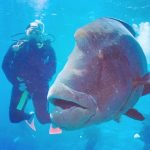
This was the most hassle-free vacation I've ever been on. We didn't communicate with the About Australia group very much before the trip simply because we didn't have to. They had all of our travel documents completely organized and squared away. To be honest, I was a little nervous checking into our first hotel in Melbourne simply because I never confirmed that we had a reservation. We d(...)
This was a terrifically planned trip. The detail of the planning by About Australia was amazing. Our trip was 7 weeks long and offered us a great opportunity to see & do as much as possible. When weather changed a planned route, our travel consultant, Ana, was quick to rearrange our travel. She was there to answer my many questions by quickly responding to my emails. I am totally impres(...)
After the initial scare of missing our connection in Dallas, because our Denver to Dallas plane was running late, we were rebooked by American Airlines via Los Angeles. After that, every connection, shuttle, hotel, tour was perfectly coordinated. Our trip was a great taste of life in Australia without all the hassle of attempting to book all arrangements ourselves.
Koda was absolutely amazing. Truly the best trip of our lifetime. We cannot thank you all enough for this. We will always use Koda for future trips. 100% satisfied. About Australia will be referred by us to everyone.
Ana did a great job of putting my itinerary together. She has great ideas for tours, the accommodations were fantastic, and it was nice to have transportation arranged to and from the airport.
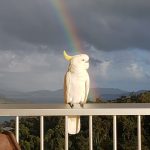
Darin hit it out of the ballpark planning our trip to Australia for us. He made it very easy for us to get from one place to another. Everything went as planned!! He suggested Hamilton Island to us and It was one of our favorite places to go! Absolutely beautiful! Everyone was so friendly and they take such good care of their Island- very clean! We were able to see and do so much and all do(...)
This was one of my bucket list vacations and Anna Musgray and About Australia did not disappoint. I cannot
believe everything went smoothly without a single hitch. I expected at least one thing to not go as planned,
but was most pleasantly surprised that each and every detail was spelled out for me and completely followed
through. I'm so glad I made this trip because it was wonderful in(...)
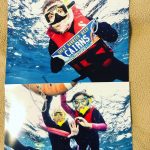
Koda and her company were a dream to work with. Everything was easy to understand and tailored to meet our needs. This was our first time using a tour type package and agent and I was glad we did. Our trip was planned out beautifully for us. Everything was streamlined, easy, fun and friendly with top notch impeccable services, tours and hotels. We had a great balance of scheduled tours and ti(...)

I had a nice time in Australia. Had the opportunity to meet 4 other women on a similar adventure from various parts of the US. Their package very similar to mine so we spent time doing activities together and having meals together.
I would recommend that you ask more questions about the activities if you are going to book them through the travel agency. There was very limited information g(...)
We got such a great deal, it made me wonder “what’s the catch?” No catch, just a wonderful adventure!
Marissa really helped us plan the perfect vacation. She was always available by phone or email, even sometimes after hours. I had a lot of questions and made some changes, and she was very accommodating. We were visiting our son who is attending the University of Newcastle for a semester. We stayed in Sydney and Newcastle during our trip. Some of our favorite things were the sunset cruis(...)
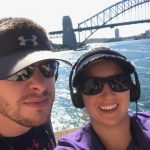
We really enjoyed the tours that we were scheduled for. The guides on all the tours were excellent, they were all knowledgeable, a lot of fun, we enjoyed chatting with everybody.
I wrote as soon as we got back, but the email did not go through. You did a superb job of booking everything! The trip was perfectly smooth. Both Australia and New Zealand are beautiful and the people are kind. We snorkeled, zip lined, walked, went on planes, trains, gondolas, boats and ferries. We attempted to do every activity and site available and I think we succeeded! Thank you. (...)
All our vacation to Austria was planed by the agency and we were very happy to follow the schedule for each locations we visited. The schedules were easy to follow and it gave us a good opportunities to see all about Australia and histories.
Just wanted to share we had an amazing trip through New Zealand and Australia, thank you for coordinating the trip. The voucher process worked perfectly and we liked the location of the accommodations. Wish you did Asia, I would love to use your services again.

Our Aussie trip could not have been planned better. The accommodations were all located centrally within short walking distances to restaurants and shopping, not to mention each one was ever so clean and the staff so friendly. The tours scheduled were just what we wanted to see and the tour guides quite knowledgeable. We got to see all the Koalas, kangaroos and wombats that we could possibly(...)
The trip to Australia was amazing. The tours were well planned and interesting. A great value for the money.
My husband and I went to Australia September 2019. From the beginning of our planning process Melanie was great. Initially we planned to go on vacation in June but we had some conflicts so requested to move our vacation to September. Since Melanie was out of the office, Melissa helped us get everything organized. Melissa was so great and attentive as well. As our vacation got closer Melanie c(...)
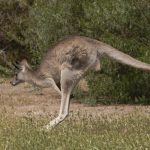
Everything was perfect for our trip. Everything I wanted to see and the package Chris put together was perfect. It was action packed but got to see everything we wanted to see. Working with About Australia was smooth and an easy process. Chris spend a lot of time putting the package together and we couldn't be more pleased. All the hotels were in great locations for us to visit the sites. C(...)
We had a wonderful trip. Koda's help in planning all aspects of the trip was wonderful. Having never travelled abroad before, we relied heavily on her to help us with planning our travels while in Australia. All bookings were perfect for our likes. We only had one hiccup on a planned tour which was cancelled (no fault of Koda), but didn't bother our trip in the least
They helped me plan a amazing anniversary trip that I will never forget. We had minor hicks up but it was taken care of. I just wanted to share how much I enjoy dealing with About Australia. You have great people working to make business travel as painless as possible. I have worked a lot with Chris Reech – he is brilliant.
He is customer focused, cheerful and always willing to help you f(...)
Daren and his colleagues did a wonderful job in getting us set up for our first tour of Australia. We will return to the Land Down Under again and will be certain to engage their assistance in putting the next visit as well.
About Australia Travel Agency and Christopher R (agent), did a great job in organizing, communicating and providing me and my husband with top notch accommodations and exhilarating excursions. Even though we had a few glitches due to acts of God, everything else went as planned. I give them an 'A' for a job well done.
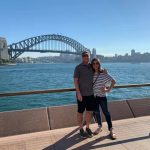
We had the best time and I highly recommend Ana & the "About Aus/NZ" team. I looked into a lot of different agencies prior to planning our honeymoon to Australia and New Zealand. Truth be told, I originally planned to complete all aspects of our trip myself. When finding the "About" team, I loved that they specialize in only a few different places. I also liked how they gave us the ability to(...)
About Australia (Joanne) did a great job working with us and customizing our trip. It was what we wanted. We certainly saw the bush and outback several times. We found animals in the wild besides at sanctuaries and Steve Irwins Zoo. We believe we saw the real Australia and not just cities. The train trips were what we expected and then some. When they stopped and let us off it was very (...)
It was amazing, the experience was well worth the cost.
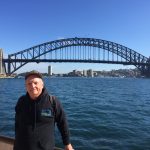
Traveling to 3 Australian cities, I was surprised how effortless the whole trip was. The hotels were very nice, the pickups and transfers from airports were efficient, the included tours were fun, and it was an all around enjoyable and worthwhile experience.
Australian people are incredibly hospitable and fun to talk with. One story: When we disembarked our train early in the morning in Cooroy, there was no station, just a platform on a country road and no taxi stand. But there was a group of guys meeting up to go kayaking. One offered to drive us free the 30 minutes to our destination ---- the attendant in a filling station was able to call (...)
About Australia was amazing to work with making this a vacation of a lifetime! I would highly recommend their services to anyone wanting to travel to Australia. The itinerary was great. The hotels we stayed in were not only wonderful, but were located in super convenient in relation to exploring the cities we were in. Any questions or concerns i had were immediately addressed. Customer servic(...)
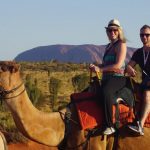
We used About Australia for our 2 week honeymoon. They were very easy to work with and helped us create the perfect itinerary. I loved how customizable everything was and it was very reassuring knowing everything was taken care of. We only had one issue the whole time and that was with our pickup from the airport when we first arrived in Sydney. It wasn’t the way we wanted to start our honey(...)
The trip that Ana put together for us was nothing short of spectacular and exceeded our expectations which were high. As we traveled from Sydney to Hamilton Island to Byron Bay and back to Sydney we were able to enjoy all the sites and activities we planned and then some! We were privy to some “insider tips” which added so much to our trip. We highly recommend AboutAustralia and plan on using(...)
Absolutely no complaints! Great accommodation! Everyone was on time to pick us up! Really enjoyed Australia!
I asked for a trip to Australia focused on Australian animals and I enjoyed it immensely. I petted koalas at the Australia Zoo and at several wildlife refuges, and photographed them out in the wild. I fed and petted kangaroos and wallabies at the Australia Zoo and at several wildlife refuges, and photographed them out in the wild. While snorkeling on the Great Barrier Reef, I photographed mul(...)
Koda was great and kept in contact with us from the intial point and until our return and beyond. All of the events we booked were fantastic. Even though we were fresh off the cyclone the snorkeling of the Great Barrier Reef is a once in a lifetime experience. The tip about getting something for the flight crew paid off as all the flight crew treated us as though we were VIP's and other peopl(...)
Best Vacation EVER! I'm not one to write reviews - but our trip to Australia was perfect in every way. From the flights, to the transfers, accommodations, & excursions - everything went without any hitches. Accommodations were comfortable, and the people so very nice. We have NO complaints.
Ana, our rep with About Australia, put a trip of a life-time together for us. Thank you (...)

Tyler planned an amazing trip to Australia and New Zealand! Everything went smooth from the time we left Newark until we landed back home in Newark. The flights were great, the transfers went smooth, the accommodations were lovely and the excursions were awesome!! Any issues we had were out of everyone’s control and handled appropriately
I would recommend About Australia to anyone who (...)
We enjoyed a great time in New Zealand. We particularly enjoyed the scenic South Island, and Hobbiton on the North Island.
Our trip was so smooth and so affordable we could not believe it! Accommodations were wonderful - clean and right in the middle of the action in all 3 areas we travelled. Flights were wonderful and transfers reliable and on time. I cannot think of a way it could have been better!
Great trip. Loved every moment of it. Just what I wanted and more.
Booking through About Australia made the trip very easy. It was nice not to worry about finding accommodations and flights and they provided good recommendations for each location. I would use the service again. I did feel that we spent too much time in some places and not enough in others, but that likely kept flight costs down.
My only concerns were that two of the accommodations didn't (...)
Awesome trip, can’t wait to do another!
My husband and his brother had a very nice time in Australia. Thank you for your help in coordinating this adventure.
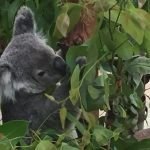
Ana did a great job! In less than 3 weeks we saw the top spots ob Australia's south, middle and north. Everything was well organized, just showing the voucher and we could pass.
Everything went well from transfers to tours. We had a 4 hour hiccup with the first flight, but United and Qantas redirected us. We had an extra flight but missed only a few hours of our time on Gold Coast. Tours were a nice addition to the base tour. Wished we had more time in Sydney, but we plan to go back.
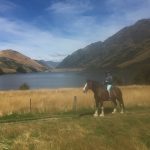
Ana Musgray helped me plan my dream trip to Australia and New Zealand. Everything was so well organized all the transfers,or coach buses were right on time and ran seamless. This county is absolutely beautiful and the people on my tour were so much fun! I had the time of my life and will never forget my amazing holiday! I hope to return one day and will definitely contact Ana again.
Great travel services covering customized locations and activities. Transfers were seamless and
Accommodations were perfectly located with access to in apt.laundry needs at just the right intervals
for our three week trip. Couldn’t have asked for a better team in getting us flight changes mid-trip and
tracking our needs throughout. All for reasonable prices! Best of the best!

Thank you for putting together such a great vacation for us, very professional service. We had a blast in Australia!
This is my second time booking with About Australia. It was a blessing and pleasure to work with Koda! She was patient, efficient, and did her utmost to meet all my travel requests. I had a customized itinerary with many changes in between. Koda, without any hesitation, helped to meet my requests. Koda delivered friendly and professional services without any trace of Being annoyed or bother(...)
I’m extremely happy with the trip that we had About plan for us. I told them what cities we wanted to go, what attractions we wanted to visit and that we were nature lovers. They planned the best tours for us and nailed it! I was also very happy with the smoothness of all the connecting flights and the shuttles to and from the airports/ train stations.
Koda did a great job proposing and organizing our itinerary. She kept us informed of any changes, gave us excellent advice, and reminded us of important things we need to do. We had a wonderful, memorable and very smooth trip. Hope to do business with you again in the future.
The whole trip was very well organized . Starting with planning the trip consulting Darin Hendry, he made us feel very comfortable and assured us that we would be well taken care of. He told us what to expect at every cities we stopped. The instructions at each airports when we arrived were so detailed. We felt so at ease in unfamiliar places. The whole trip was very relaxed because we travel(...)
Thank you for making this amazing trip happen!
We couldn't be happier with our trip to Australia that we booked through "About Australia" Travel Agency. Our agent Ana, helped us customize our trip & figure out 3 cities to visit & an excursion in each city to do. The accommodations were convenient & comfy. The excursions got us out & about the city so we could figure out more places we wanted to visit. Ana walked us through getting all o(...)
Our first trip to australia is awesome . Quantas airlines staffs are attentive , helpful to meet my needs & assistance .hotels & apartments provided are awesome , clean , spacious & most of all matrtra on kent , very close proximity at darling harbour in sydney. Tours best is penguin , barrier reef .the only minor complaint i have is to remember to call transfers 24 hours prior . . Australia (...)
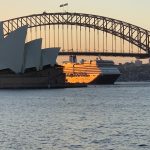
Australia is beautiful. Our trip was well planned and very organized. Daily vouchers were easy to understand and all travel documents were very organized. Darin was extremely helpful and readily available for questions and concerns. I would definitely recommend About Australia for your travel needs.
Awesome,fantastic,wonderful not enough words to describe this experience. It was the best! Everything went smoothly not one glitch in the entire 3 weeks. All the tours, transfers were as described. Couldn’t have been a better experience.
Thank you Ana ,you are the best and very professional.
Amazing trip to Australia !!!!!!
Very soon will be back with our son Richard.
Sincerely,
Acelavguerra
This is my 2nd time booking with About Australia. It was a blessing to work with Koda this time around! She provided outstanding services all around from the time I phoned in to during the trip and the end of the trip!
Koda was very patient, efficient, and tried her utmost to meet all my travel requests.
I had a customized itinerary and Koda diligently and patiently worked with me on (...)
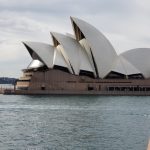
Every thing was above our expectations. If we knew better, we would have spent more time in New Zealand. All hotels were great except our hotel in Sydney which did not have the best location for our needs. Thank you so much!
TO BE FILED UNDER... WHO NEEDS A TRAVEL AGENT ... UNTIL YOU DO!
We traveled to NZ and AU in March and April this year. After a great deal of discussion with friends and colleagues about where to go and how much time to spend, we headed off.
NZ was first, not only was it one of the most spectacular Venues i have ever been lucky enough to visit, but the driving on the "Other side of the(...)
My travel agent Darin, did a spectacular job with my tour itinerary, everything was beyond my expectation. all the hotels and their staff, were cordial, helpful and full of important information. the location of the hotels was fantastic, everywhere I wanted to see or visit was at walking distance, it was safe which was one of my main concerns, Darin assured me that everywhere I was staying wa(...)
About Australia put together a perfect trip for us to Australia. Their suggestion that we fly Premium Coach on Virgin Australia worked out great, we slept well both ways and literally experienced no jet lag either direction. We were pleased with all of our accommodations and excursions, and when one of our flights inside Australia was cancelled, the owner was immediately on top of the situa(...)
So glad About Australia and Koda could make my dream come true. Such an incredible trip. Managed to accomplish so many things: Great Barrier Reef, Tjapuka dinner show, whitewater rafting, Wildlife Dome (picture holding koala bear), shopping, Blue Mountain tour (feeding and petting kangaroos), seeing 3 Sisters, using 2 day Harbour Pass to visit most stops, walking the Harbour Bridge and Ro(...)
I reviewed properties with the travel agency which had some issues, and these comments are said to be considered for future clients. I'm awaiting resolution of an airline baggage charge with which the agency is assisting.
I'll try to post photos after I'm back from catchup mode; having been away a month.
Thank you Ana, for your great service!
Australia is a big country!! We are so glad we used "About Australia" tour and self-guided services!!!
Sydney was a beautiful city!! clean and lots of action at Darling Harbor ... Our accommodations were two blocks from Darling Harbor ... Easy walking distance to everything: Sydney Opera House, Harbors, Fish Market, and boat taxis to Manly...
The first half of the trip we used three(...)
We had a great first time trip to Australia. Darin and About Australia were great to work with. The sites we visited were fantastic. The hotels were excellent. The day trips and operators were first tier. Everything about the trip went smooth and was above expectations. Well Done!
Chris was great at helping me plan my trip to visit my daughter in Australia while she was studying abroad. We had 2 weeks and a tight budget! He was great at accommodating me. We decided on Cairns, Sydney and Melbourne. The only hiccup was the transfer from Melbourne airport to hotel. The company called con-x-ion (I think that’s how it’s spelled) had the smelliest van I have ever been in. Th(...)
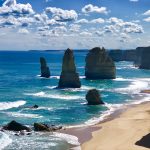
A most excellent vacation as a result of working with Marissa Stroud! Perfect accommodations, wonderful tours, and accommodating flights with Virgin Australia.

We had a wonderful time. We enjoyed all of the excursions that were included with our package. We would, however, preferred better hotels. The first one, in Melbourne, was located about 2 blocks from the office where we were dropped off by the shuttle. We had to drag our luggage to the building. We found the apartment to be well appointed, but we had to report to the management that the (...)
Thoroughly enjoyed our vacation - Princess cruise New Zealand was great. Hotels in Sydney, Gold Coast were excellent, our hotel in Cairns the room itself was lovely, unfortunately the view from the room was a steel roof and brick wall - again the room itself and the staff were very nice.
Great flights on Qantas, excellent room accommodations (awesome view from Short Stay apartment in Melbourne), loved being up-close with koalas, kangaroos, wallabies , and adorable fairy penguins. Our guides, Monique and Yasmin, were lovely, and snorkeling on the Great Barrier Reef, was amazing! Australia should be on everyone’s bucket list!
Koda was very helpful in assisting us in planning our first trip to Australia. The apartments in Melbourne and Sydney was Amazing. It is walking distance to major attractions and we felt very safe. We will definitely recommend about Australia to our friends. Thank you.
Thanks, Darin, for the wonderful trip you designed for us in Australia. We had a blast! The hotels were right in the middle of things, the tours were amazing and first class, and if I needed advice you were right there for me. I would not have been able to plan this trip without you because you had been to Australia and you knew just where to send me, and in the style I wanted.
Thanks a(...)
Great experience. Already planning our return. Would like to single out Monique on our foodie tour. Note. Some of our contact numbers at the beginning of the trip connected but hung up after being put on hold
Thank you, Darin for planning our trip of a life time to Australia, New Zealand and Fiji. The whole trip ran smoothly because you had everything set up for us. All the tours were top-notch and beyond enjoyable. The fact that we didn't have to go through the hassle of buying tickets for our tours was super, definitely made our trip so much easier! We seen and experienced so much that we never(...)
3 countries, 13 flights, 31 vouchers, 0 problems.
This was a well orchestrated trip by Ana at AboutAustralia of Australia, New Zealand and Papua New Guinea.
Really wonderful trip. Everything was arranged ahead of time. All hotels were great. The tours were lovely, including the optional daintree dreaming tour. Well, well worth the money
My daughter and I had an amazing time Down Under thanks to About Australia. Our hotels were wonderful and located perfectly in order to explore more of the cities we were visiting. All of the recommendations before we left were extremely helpful. It made a last minute trip into a relaxing vacation.
Can not describe how wonderful this trip was. Every flight perfect with pickups always on schedule. Each hotel was better than described. The excursions where a highlight of every city and where very fairly priced. We added some additional tours and Chris Reeh our agent from "About Australia" handled these additions with ease.
We enjoyed every day and night . Pickup for tours always on time(...)
Our trip to Australia would never have been as successful as it was without the help of Koda from About Australia. Using an area specialist made all the difference. She set us up with amazing excursions I doubt we would have found it n our own. She suggested the Phillips Island trip to see the tiny penguin parade when I didn’t even know there were penguins in Australia—and trip included (...)
I was referred by a friend to About Australia to help put together my "bucket list" trip to Australia and New Zealand. Overall, it was a great success. I saw and did all the things I really wanted to do. High points were the Sydney Bridge Climb, diving the Great Barrier Reef, the Penguin Parade on Phillip Island, driving the Great Ocean Road, hiking in Freycinet National Park, and the feeding(...)
I went with confidence in About Australia, and ended with confidence with About Australia. Our travel Agent Daren did everything possible to make this a unforgettable trip, and he succeeded. He even went out of his way to change our plans at almost the very last minute. this is very special from a very special person. I certainly have and will recommend them to anyone wanting a trip of a li(...)
Great planning, awesome communication, and perfect itinerary setup by Kelsey!! Perfect hotel locations to access the wonders of each city within walking distance!!! Australia was amazing, adventurous, and relaxing!! Great job About Australia!!
Read more About Australia Reviews
You May Also Like
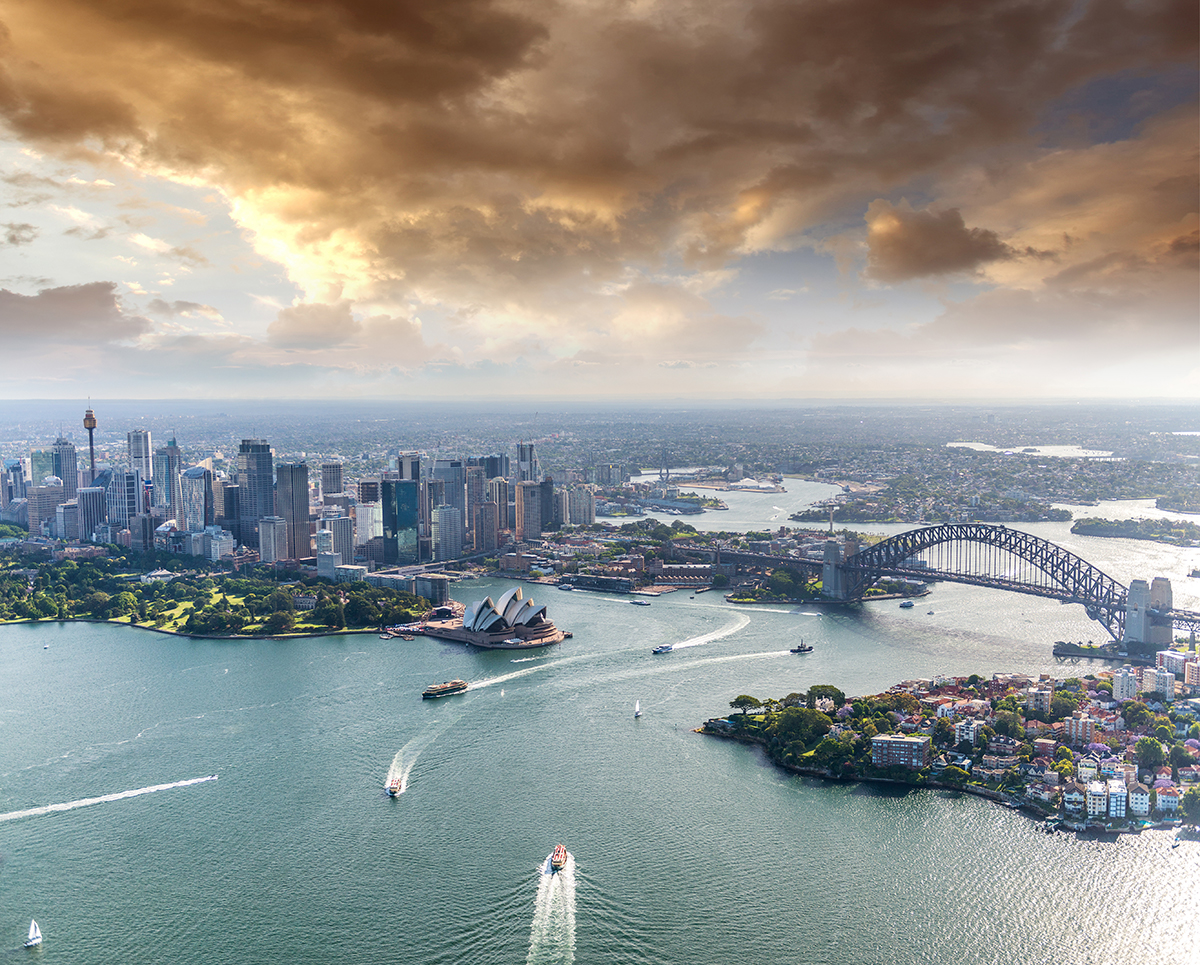
|
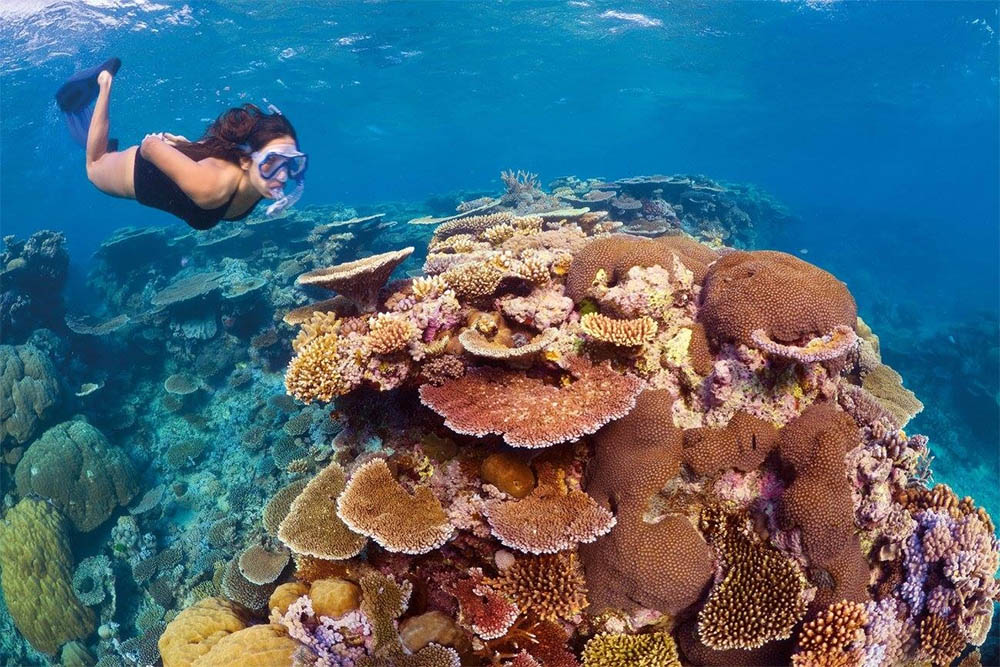
|
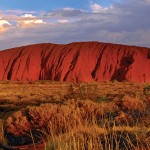
|




